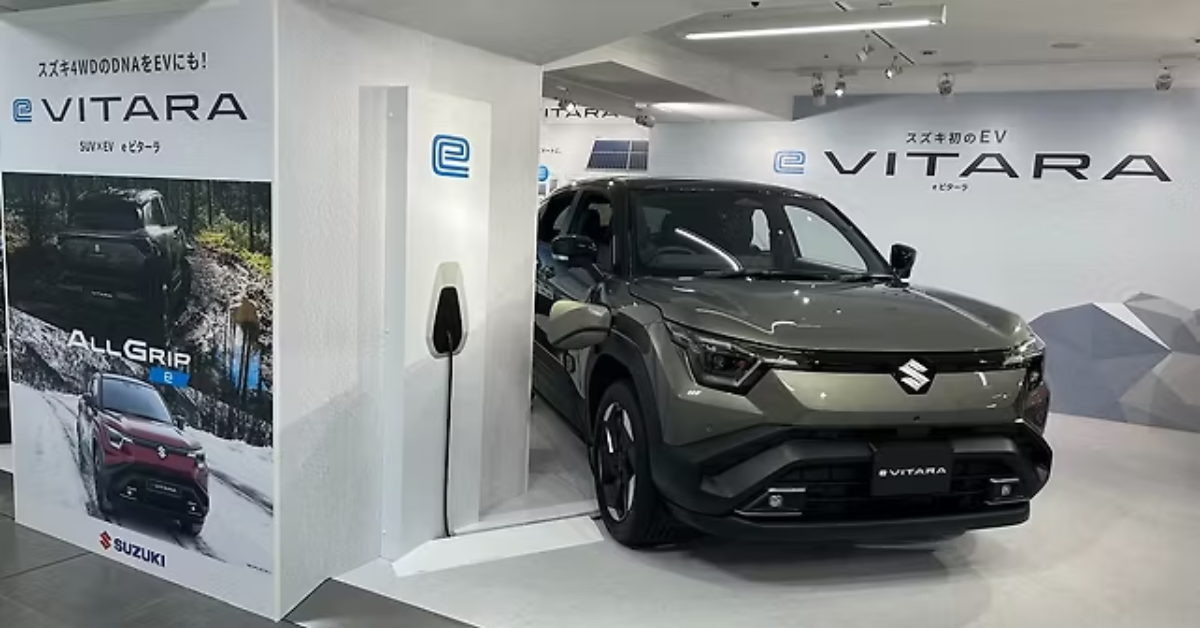In a significant milestone for India’s growing electric vehicle industry, Maruti Suzuki’s e-Vitara, manufactured entirely in India, has been showcased in Japan, marking a powerful symbol of India’s rising capabilities in EV development and exports.
The debut of the e-Vitara in Suzuki’s home market not only highlights the technological progress made by Maruti Suzuki India Ltd. (MSIL) but also signals the company’s ambition to become a global EV player, using India as a manufacturing and innovation hub.
Here’s an in-depth look at the India-made Maruti e-Vitara, its features, export strategy, and why this development matters on a global scale.
🚙 What is the Maruti e-Vitara?
The Maruti e-Vitara is Maruti Suzuki’s first all-electric SUV, based on the successful Grand Vitara platform. It represents a crucial part of Suzuki’s global EV roadmap and is expected to cater to both domestic and international markets.
Key aspects:
- Built in India, primarily at Suzuki’s facility in Gujarat
- First global EV model by Maruti Suzuki
- Previewed earlier in India under test mules
- Showcased in production-ready form in Japan in July 2025
This electric SUV is expected to officially launch in India in late 2025, with exports to global markets like Europe, Southeast Asia, and Japan following closely.
🔋 Expected Battery, Range, and Powertrain
Though Maruti has not officially released specifications, based on reports and global benchmarks, here’s what we anticipate:
- Battery Pack: 60 kWh (Li-ion, liquid-cooled)
- Range: 500–550 km (ARAI), approx. 450 km (WLTP)
- Motor Power: Around 135–150 hp
- Torque: 250–300 Nm
- Drive Type: Front-wheel drive or optional AWD (higher variants)
- Charging: Fast-charging support up to 150 kW DC
- 0–80% Charging Time: ~40 minutes (DC)
These figures would place the e-Vitara ahead of rivals like the MG ZS EV and on par with the Hyundai Kona Electric.
🌐 Why Japan? The Global Strategy
Suzuki Motor Corporation has long used India as a cost-effective and high-capability manufacturing base. The decision to showcase the e-Vitara in Japan, produced entirely in India, highlights several strategic goals:
- Establish India as a global EV export hub
- Leverage India’s manufacturing advantage to offer competitive pricing globally
- Test Japanese market response to India-made electric models
- Fulfill Suzuki’s commitment to electrify its global portfolio by 2030
By showing off an India-made electric SUV in Japan, Suzuki is reinforcing trust in Indian quality standards, especially in an advanced market known for strict regulations and demanding customers.
🧩 Design & Exterior Styling
From the official unveiling in Japan, the Maruti e-Vitara retains the rugged, upright SUV stance of the ICE Grand Vitara, but with modern electric touches:
- Closed-off EV front grille with blue accents
- Signature LED DRLs and headlamp setup
- New aero-optimized alloy wheels
- EV badge and updated rear light bar
- Flush-type door handles (likely on top trims)
- Aerodynamic enhancements for better range
While staying true to its SUV roots, the e-Vitara adds a clean and futuristic look befitting an electric vehicle.
🛋️ Interior & Cabin Experience
Inside, the e-Vitara is expected to offer a premium, connected experience, with most features shared with its ICE sibling but with EV-specific enhancements:
Key Features (Expected):
- Large 12.3-inch touchscreen infotainment system
- All-digital instrument cluster with EV analytics
- Wireless Android Auto & Apple CarPlay
- Voice assistant integration
- 360-degree camera with blind-spot detection
- Ventilated seats
- Panoramic sunroof (higher variants)
- OTA software updates
- Vehicle-to-load (V2L) capability
Cabin space, boot room, and comfort will remain similar to the Grand Vitara, ensuring family-friendly usability.
🛡️ Safety Features
Maruti aims for a high Global NCAP safety rating with the e-Vitara, and Japan’s display model hints at inclusion of top safety tech:
- 6 airbags standard
- Electronic stability control
- Advanced Driver Assistance Systems (ADAS) including:
- Adaptive cruise control
- Lane keep assist
- Auto emergency braking
- Rear cross-traffic alert
- ISOFIX child seat mounts
- Hill-hold assist
The inclusion of ADAS features indicates that Maruti is aligning with global EV safety expectations.
💸 Expected Price in India
Maruti has always maintained an affordable, value-for-money approach. Based on platform sharing and localization, the e-Vitara is expected to be competitively priced.
Estimated India Price:
- ₹23 – ₹27 lakh (ex-showroom)
- Variants likely: Standard, Long Range, AWD
Government subsidies under FAME-II and state EV policies may further reduce the on-road cost for Indian buyers.
🚗 Rivals in the Segment
The Maruti e-Vitara will go up against:
- MG ZS EV
- Hyundai Kona Electric
- Tata Harrier EV
- Mahindra XUV.e8 (upcoming)
- BYD Atto 3
While these competitors have a head start, Maruti’s brand trust, service network, and competitive pricing could give it an edge.
📦 Manufacturing & Export Plans
- Manufactured at Suzuki’s Gujarat plant, which is being retooled for EV production
- High levels of localization to reduce cost
- Exports planned for Japan, Europe, Africa, and ASEAN
- Maruti’s first serious global EV export model
India’s growing role as an EV manufacturing hub is further validated with this model, opening doors for future exports of EVs from Indian soil.
🌱 Environmental & Ownership Benefits
- Zero tailpipe emissions
- Lower running cost than petrol/diesel counterparts
- Minimal maintenance requirements
- Likely green registration benefits (road tax exemptions)
- Eco-conscious branding and modern mobility appeal
🔚 Final Thoughts: A Historic EV Milestone for India
The showcase of the Maruti e-Vitara in Japan is more than a product unveiling. It’s a statement — of India’s growing strength in automotive innovation, of Maruti Suzuki’s global ambitions, and of the rapid shift to electric mobility across the world.
For Indian consumers, this is a sign that world-class EVs are no longer a dream — they are being built right here. And soon, you might just be driving one that’s also admired across continents.

